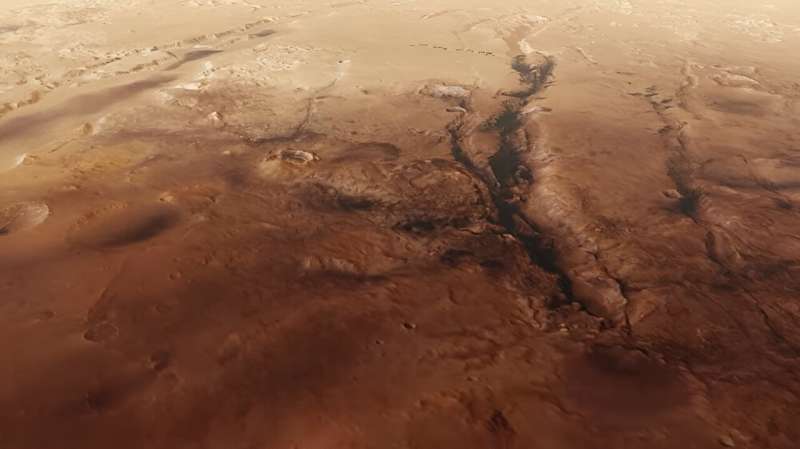This article has been reviewed according to Science X's editorial process and policies. Editors have highlighted the following attributes while ensuring the content's credibility:
fact-checked
trusted source
proofread
Video: Fly across Nili Fossae with ESA's Mars Express

Mars's surface is covered in all manner of scratches and scars. Its many marks include the fingernail scratches of Tantalus Fossae, the colossal canyon system of Valles Marineris, the oddly orderly ridges of Angustus Labyrinthus, and the fascinating features captured in today's video release from Mars Express: the cat scratches of Nili Fossae.
Nili Fossae comprises parallel trenches hundreds of meters deep and several hundred kilometers long, stretching out along the eastern edge of a massive impact crater named Isidis Planitia.
This new video features observations from Mars Express's High Resolution Stereo Camera (HRSC). It first flies northwards towards and around these large trenches, showing their fractured, uneven appearance, before turning back to head southwards. It ends by zooming out to a "bird's eye" view, with the landing site of NASA's Perseverance rover, Jezero Crater, visible in the lower-middle part of the final scene. (You can explore this crater further via ESA's interactive map.)
The trenches of Nili Fossae are actually features known as "graben," which form when the ground sitting between two parallel faults fractures and falls away. As the graben seem to curve around Isidis Planitia, it's likely that they formed as Mars's crust settled following the formation of the crater by an incoming space rock hitting the surface. Similar ruptures—the counterpart to Nili Fossae—are found on the other side of the crater, and named Amenthes Fossae.
Scientists have focused on Nili Fossae in recent years due to the impressive amount and diversity of minerals found in this area, including silicates, carbonates, and clays (many of which were discovered by Mars Express's OMEGA instrument). These minerals form in the presence of water, indicating that this region was very wet in ancient Martian history.
Much of the ground here formed over 3.5 billion years ago, when surface water was abundant across Mars. Scientists believe that water flowed not only across the surface here but also beneath it, forming underground hydrothermal flows that were heated by ancient volcanoes.
Because of what it could tell us about Mars's ancient and water-rich past, Nili Fossae was considered as a possible landing site for NASA's Curiosity rover, before the rover was ultimately sent to Gale Crater in 2012. Another mission, NASA's Perseverance rover, was later sent to land in the nearby Jezero Crater, visible at the end of the video.
Mars Express has visited Nili Fossae before, imaging the region's graben system back in 2014. The mission has orbited the red planet since 2003, imaging Mars's surface, mapping its minerals, studying its tenuous atmosphere, probing beneath its crust, and exploring how various phenomena interact in the Martian environment.
Provided by European Space Agency



















